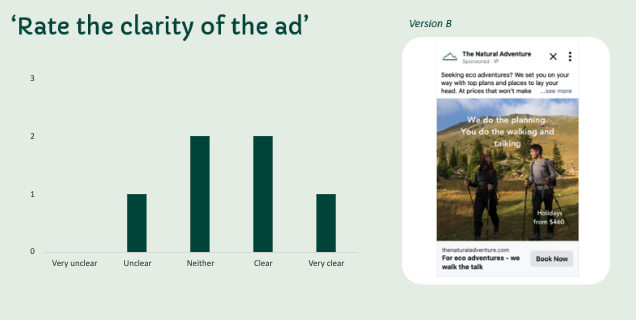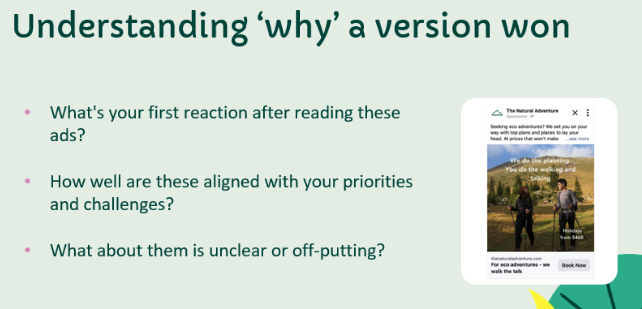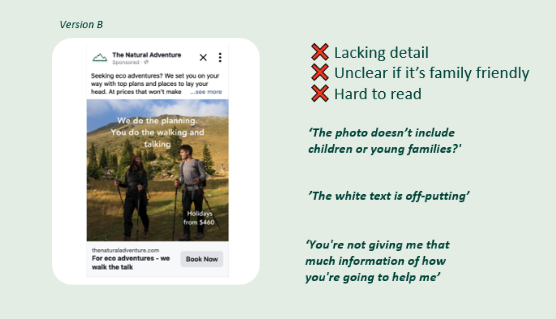By Amy Hind, CRO specialist, Launch
Understanding your customers is a crucial part of connecting with them. In today’s crowded paid media landscape, this is an area where you can get an edge over the competition as the sales peak of Q4 approaches.
In this blog post, I’m unpacking how qualitative user research can add value for your business, regardless of its size, and how starting early can give you the edge.
I’ll spell out the benefits of customer research (such as gaining deeper insights into your audience’s needs and behaviours), which line you up for a boost in conversions and ROAS.
Based on my own extensive experience of user research, I’ve included tips for where to focus your research efforts, from ad impressions to the checkout journey, and how to analyze the results for peak impact.
From e-commerce giants to small, niche businesses, you’ll find advice to help you optimise user experience and prepare for a successful peak period. So, without further ado, let’s dive in.
Why should you be doing user research?
Why not!? Taking time to perform user research provides you and your business with invaluable insights into target audience and your existing user base.
Being able to harness these insights means you’re not shooting blind. It allows you to get the best performance possible during the peak period.
We’re months away from peak period – why do I need to think about customer research now?
To be well-prepared for Q4 – peak period for so many businesses – you really should be starting to think about optimising your paid ads and website well in advance. It’s a marathon, not a sprint and the process will likely span months rather than weeks.
By starting early, you allow yourself the time to ensure your ads and website are performing to the best of their ability. There’s nothing worse than only learning what works once the high-intent period has arrived.
Invest the time now to refine your strategies, creative, and site performance so that you’re prepped and ready for success when the rush hits.
Who will benefit from customer research?
Everyone – don’t be shy! There’s a common misconception that customer research isn’t appropriate for smaller businesses with a niche ICP, but this isn’t an issue in today’s market.
There’s such a wide range of tools available, anyone can easily access a whole world of people and target specific audiences, no matter how niche (a recent example of mine: business owners who use self-storage units).
This means that user research is no longer an inaccessible practice.
With the approach of Q4 in mind, those who see their peak in this time should be especially focused on carrying out their research. For example, ecommerce and travel industries would benefit the most from starting now.
What results can I expect by doing customer research to prepare for peak?
Broadly speaking, you get a much deeper understanding of your target audience, including their anxieties, fears, and needs. This is crucial for creating a holistic view of your user base. In short, it’s the only way to truly understand your audience.
Exploring the entire conversion journey, from your ad content to landing pages and ensuring your site is intuitive and user-friendly, means you can troubleshoot issues and optimise the full user experience.
A deeper level of understanding provided by qualitative research can also help to harness the maximum potential from your leads. This means an uplift in conversions and click-through rates, ultimately leading to a better return on ad spend (ROAS).
Where should I focus my customer research efforts?
As hinted above, user testing isn’t limited to websites alone.
Integrating paid media and website research provides a holistic view of the entire acquisition journey (the resources from Launch’s CRO event go into this idea in detail).
For example, getting your users to feed back on their first impressions of an ad: where they would expect it to direct them, and how the appropriate landing page does/doesn’t match their expectations, allows you to troubleshoot areas within that path that may be disjointed and unintuitive.
Don’t worry, this doesn’t mean that every nook and cranny needs to be put under a microscope. Pick the areas that are relevant to that core conversion journey, eg:
- Which ads get the most impressions?
- What are your most popular landing pages?
- How’s the checkout journey looking?
Find what’s important for your business.
What do I need to look out for when analysing the results of my customer research?
Try to keep your mind open to anything when you go into your research project. It’s completely normal and healthy to be surprised by the insights you uncover, and often these nuggets of information can produce the most substantial changes.
If you try too hard to pull recommendations from super specific places, you run the risk of confirmation bias.
The most important thing is to keep the experience being tested as authentic to the user journey as possible. Keep questions open-ended and allow your participants to feedback organically. The screengrabs below illustrate some questions we asked during qualitative research, and how we measured results.


How can I extract insights from my customer research?
The short, obvious answer to this is just do research!
Figure out what part of your journey you want to optimise, how much resource you have available and what scale you want to be researching on.
It’s not a one size fits all process. Take time to decide which research methods will best fit your needs and go from there.
If you need support, you could look into contacting a CRO agency (here at Launch, for example, we have a CRO team)
I also talk through some specific methods in this webinar:
You can also watch Joe and Josh’s webinar on 4 ways to understand your customer more through CRO:
I have the data from my customer research, what next?
Once you have your feedback and a collection of observations from your users, it’s time to turn them into insights. Pick out the common threads that run throughout your findings and form them into substantiated insights (see image below for an example of how we have turned comments into tangible feedback).

Once you have your insights, you can start thinking of solutions. Turn these recommendations into hypotheses and you’re ready to get testing!
Need help with preparing for peak performance?
The performance marketing team at Launch is here to help. If it’s customer research you’re interested in, our CRO team is experienced and gets results. Get in touch to let us know what you’re working on and how we can help.
We also have an upcoming event on peak performance. Find out more and get tickets. The resources from our last peak performance event may also be helpful.



